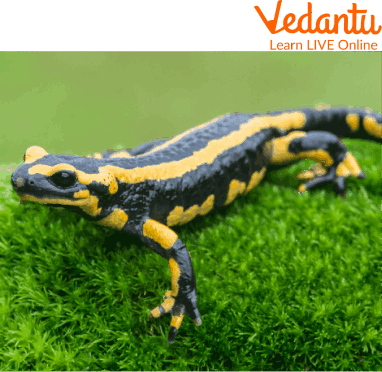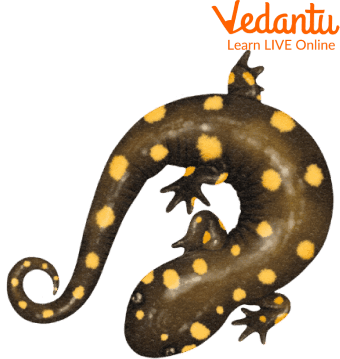




What Makes Salamanders Unique? Key Features and Adaptations
The Salamander is an amphibian animal mostly found in Eastern North America. They are characterised by a lizard-like body, blunt nose and snout, and four limbs. They come in a wide variety of colours and patterns. Since they are amphibians, they can live on land and water, just like frogs. Below are some of the salamander pictures for your reference.

Salamander
They feed on insects and other creatures comparable to their size like crabs, fish, frogs, moths, spiders, etc. In this article, we will look in detail at this species of animal. We will see salamander pictures, learn about ‘where do salamander live,’ ‘what do red salamanders eat,’ and some more interesting salamander facts for kids.
Where Do Salamander Live?
Salamanders are amphibian creatures. This means they can live on land as well as in water. However, not all salamanders are the same. Some species live entirely in water, and some are entirely terrestrial, i.e., live on land. There are approximately 760 species of Salamanders. North America is home to about 33 % of these species.
Salamanders are mostly found in the Northern Hemisphere of the earth and South America (excluding the Amazon region of South America). This implies that they are not found in India.

Salamanders are Primarily Found in the Northern Hemisphere
Due to the permeability of their skin, they are typically restricted to living in or near water or in other chilly and wet environments. Some species of salamanders remain completely aquatic for their whole lives, while others only venture into the water occasionally, while others spend their entire lives on land. We hope this answers the query of where do salamander live.
Interesting Salamander Facts for Kids

Yellow-spotted Salamander
A salamander is a very interesting creature. Here are some very interesting salamander facts for kids to marvel at.
1. Salamanders Lived Even Before Dinosaurs!
The rock layers in China and Kazakhstan have yielded the oldest Salamander remains yet discovered. These fossils have indeed been traced to the mid-Jurassic period, which occurred approximately 164 million years ago.
2. Some Species Can Grow Really Large
In spite of the fact that the majority of salamanders only grow to an average length of between two and six inches, there are some species of giant salamanders that are regarded as the biggest amphibians on the planet. For example, the Japanese giant Salamander, which is considered to be on the verge of extinction, has been recorded as reaching a length of five feet.
3. One Species of Salamander Has No Hind Legs!
Sirens, a type of Salamander, have vestigial front legs and gills (like fish). They have no hind legs, and they have eel-like bodies. These types of salamanders are found only in the United States.
4. When It becomes Too Cold, Salamanders Go into Hibernation
Hibernation is a process that salamanders go through in regions where the temperature is chilly by either burying themselves very deep inside the fallen leaves or slowly descending into the sludge at the bottom of rivers and creeks. The remarkable Siberian Salamander possesses another incredible talent: the capacity to survive in extremely frigid environments. It can withstand temperatures of -58 degrees Fahrenheit over three days and conditions of around -31 degrees for longer periods of time.
5. They Can Regrow Lost Body Parts!
Salamanders, in contrast to mammals, can regrow lost limbs and do not develop scar tissue. Age and species both have a role in determining this skill. In an adult salamander who lives on land, regrowing a lost leg can take more than a year. A young axolotl's ability to regrow the same leg in as little as 40 days is remarkable. Not only are salamanders capable of regenerating lost or broken limbs, but they can also restore diseased or damaged sections of their brain, heart, and lungs.
6. They Lack Vocal Cords in Their Bodies
When they perceive a threat, rather than growling, they create noises like squeaking, clicking, or biting or make noises that seem like kisses by flicking their lips or giving out quick breaths. Touching and biochemical impulses are the primary modes of communication between them.
Summary
Salamanders are a fascinating species of animals. They look like lizards but are like frogs. They eat whatever they can find and can put it in their mouth. There are more than 700 species of salamanders, most of them living in the Northern Hemisphere of the earth. They vary in size from a few inches to up to 6 feet. We talked about salamanders and their lifestyle in this article. What do you think about Salamanders? Did you like them? Do let us know in the comments.
FAQs on Salamander Facts Every Student Should Know in EVS Class
1. What do Red Salamanders eat?
When asked about what do Red Salamanders eat, they consume a wide array of different kinds of microscopic invertebrates, such as worms, small insects, and spiders, among other things. They will also consume smaller salamanders when the opportunity presents itself. Since they depend on wet environments, their range of forage alters with the changing seasons, becoming larger during the wetter months and shrinking during the drier ones.
A Red Salamander
The red salamanders that live in the Smithsonian's National Zoo are provided with a varied diet that includes crickets, drosophila melanogaster, bean bugs, copepods, springtails, and black worms.
2. Can humans die by salamander bite?
The majority of salamanders don't have poisonous teeth. So, you will not die by the bite of a salamander. Still, their bite will leave a puncture mark on your skin. However, the colourful pattern of skin that you see on their bodies does contain poison. However, their poison is not as strong as to instantly kill a human, like those of a cobra snake, if that is what you are thinking. If one handles a salamander, it is recommended to wash hands thoroughly afterwards.
3. Can I keep a Salamander as a pet?
You may raise a salamander as just a pet. As long as you give them the attention and care they need, they can make wonderful pets and survive for at least six to ten years with the right person. You will need to consider their one-of-a-kind requirements and inclinations and make certain that you fine-tune their environment and nutrition, and avoid touching them.





















